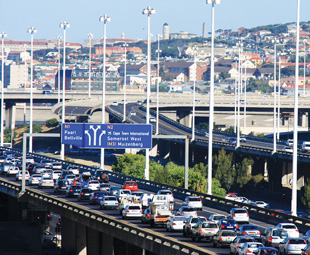Clearing the traffic jam

Road traffic is the bane of modern existence. Whilst road transport has, no doubt, improved our mobility and been a decisive factor in world development and modernisation since the early 20th century, it too has serious downsides. In this article VITTORIO BOLLO calls for businesses to become more innovative in how they contribute to traffic on our roads.
The emphasis here will be on traffic at “rush” or “peak” hours; that snarling, nasty type; the type of traffic we all dread and that seems to go nowhere. As the comedian Robin Williams once stated, “Why do they call it rush hour when nothing moves?”
There are three primary “motivators”:
The ecological motivation
Stating that pollutants from vehicles are a major impact on the environment is stating the obvious. But it must nevertheless be a primary motivation to ease up on traffic congestion. As a City of Helsinki report stated, “Vehicular traffic is one of the greatest causes of environmental harm… Traffic consumes energy, and generates noise and harmful emissions. Carbon dioxide emissions from traffic are a worldwide problem. Vehicular traffic is the main source of disturbing environmental noise. With the increase in the amount of traffic the noise carries increasingly greater distances.” Sulphur dioxide, hydrogen sulphide, nitrogen oxide, nitrogen dioxide, benzene, toluene, ammonia, carbon dioxide and carbon monoxide are all significant vehicle emissions. All adversely impact the environment.
Growing fears of climate change have also led to a greater scrutiny of road traffic. According to the London Borough of Hounslow, “Road traffic accounts for around a fifth of the UK’s total carbon dioxide emissions.” In South Africa, the government has made it mandatory that as of 1 September 2010, local buyers will pay an ad valorem CO2 emissions tax on new passenger vehicles. The tax will initially apply to passenger cars, but will be extended to commercial vehicles once agreed CO2 standards for these vehicles have been set. New passenger cars will be taxed based on their certified CO2 emissions. However, the effectiveness of these emissions standards will only be hampered if vehicles increasingly continue being stuck in traffic. Any car owner will know that a car’s fuel consumption is far higher in the constant idling and stop-go characteristic so typical of rush hour traffic. This traffic is a sure enemy of the environment.
The health motivation
Allied to the environmental impacts caused by vehicle emissions are the impacts on our health. Studies on this abound. In their 2009 study of traffic in San Francisco, Wier, Sciammas, et al rightly stated that, “Transportation planning in the 20th century [has] resulted in significant adverse health impacts.” According to the California Air Resources Board, air pollution associated with proximity to roads contributes to cancer, respiratory disease, and impaired lung development. Miedema and Vos concluded that traffic is associated with hypertension and heart disease. Further scientific reviews cited by Seto, Holt et al have found conclusive evidence of the relationship between traffic noise and sleep disturbance and mental disorders, as well as adverse impacts on childrens’ cognition, including speech intelligibility, reading comprehension, memory, motivation, attention, problem-solving, and performance on standardised tests.
Disturbing research published in The Lancet medical journal in 2000 estimated that 6% of deaths per year in Austria, France and Switzerland are due to air pollution. Half of these deaths, approximately 20 000, were linked to traffic fumes. The study by the Institute for Social and Preventive Medicine at the University of Basel, Switzerland, also estimated that traffic fumes were responsible for more than 250 000 new cases of chronic bronchitis and more than 500 000 asthma attacks each year. The study led by Dr Nino Kunzli quantified the effects of air pollution by measuring specific increases in the concentration of inhalable particles less than 10 micrometres (10 millionths of a metre) across. These particles, called PM10s, are known to be linked to disease and mortality. Friends of the Earth transport campaigner Tony Bosworth put it best when he commented, “If the impacts are the same in Britain, then … that’s equivalent to a jumbo jet crashing every ten days.”
Most tellingly, the study estimated that the cost of treating illness associated with traffic-related pollution across the three countries amounted to 1,7% of their gross domestic product, which was in excess of the costs arising from traffic accidents.
If stress is the “silent killer” of the workplace then, in my opinion, the stress of being stuck in traffic cannot begin to be underestimated either. A 2009 German study of 1 454 people who survived a heart attack, and presented at the American Heart Association’s 49th Annual Conference on Cardiovascular Disease, found that those caught up in heavy traffic have three times the risk of having a heart attack within an hour. Many of those interviewed had been driving in heavy traffic within one hour prior to their heart attack. “One potential factor could be the exhaust and air pollution coming from other cars,” Annette Peters, a researcher said. “But we can’t exclude the synergy between stress and air pollution that could tip the scale.”
The employee productivity motivation
Employees stuck in traffic for long periods, sometimes even hours, every working day cannot be good for efficiency and productivity. As traffic gets worse and more time-consuming for many employees, so it becomes one of the most hated aspects of the working day. A Regus study released in March found that traffic congestion and crowded public transportation systems were the top causes of stress and declining productivity among Hong Kong employees. As the study stated, “No business wants employees turning up to work already exhausted and stressed out, unable to function properly during the working day.”
Flexitime or any variation thereof is definitely one means to combat the ever-growing sprawl that is traffic. Allowing people to come to work and leave work at different, staggered times, for example, should go some way to easing traffic burdens, in that the “rush hour” will become less defined, more dispersed. There have been countless studies on the benefits of flexitime for employees. Pursuant to its Hong Kong employee study, Regus stated that, “…we advocate flexible working locations and hours to avoid all these [traffic-related] stresses and strains which can have such an adverse effect on employees’ throughput, motivation and happiness. Travelling to a work location closer to home, especially outside peak hours, is often the best way to avoid sources of stress for a happier, calmer and ultimately more fruitful day’s work.”
Michelle McGinty wrote in The Independent that, “Flexibility is the 21st century buzzword in the workplace.” She goes on to cite how, “the figures supporting more flexible working are persuasive. A recent study revealed that
70 per cent of senior executives who were in a job-share were generating 30 per cent more output than one person doing the same job. And another study revealed that 85 per cent of human resources managers believe allowing flexitime improves both morale and motivation among staff.”
Certainly, flexitime seems more feasible in the services industry and for those employees who are office-bound. The logic is that flexitime is simply not practical in manufacturing or long-distance haulage, for example. But even that paradigm is slowly changing. As the UK’s K3 Business Technology Group opines, “Flexible working is part of the solution for many manufacturing and distribution companies facing shrinking order books to maintain the nucleus of their skilled staff. Businesses realise the value of the skills, knowledge and experience of a loyal workforce. Without them, they will not be able to react fully to an economic upturn.”
Patrick Karani of the Development Bank of Southern Africa made the very pertinent point that, “Roads are effective but not efficient modes of transportation.” They are even less so when choked with traffic. Our’s is a country where the government insists on spending far more money on expanding existing roads and building new roads than on extending viable public transport. Let’s face it – public transport in this country is either non-existent, irregular, impractical or downright dangerous. We, therefore, need to do everything we can to curtail our time spent on the roads, and especially at rush hour.
To conclude: Traffic congestion is worsening, and traffic is an enemy in our midst. Every feasible, reasonable effort must be made to stop the ecologically unsustainable, stress-inducing madness that is the eight-to-five obsession in this country.
Author H G Wells wrote, “Every time I see an adult on a bicycle, I no longer despair for the future of the human race.” Fine sentiments indeed, except try riding a bicycle to work in Johannesburg, or Durban, or in most places in South Africa. For now, we must make do with our enslavement to the motorcar and the taxi. As such, we need to be more open-minded and even radical about the very way in which we get to and from work.
Vittorio Bollo achieved an LL B in Law and Politics from a UK university and a Master’s degree in International Environmental Law from a Canadian university. He has over 12 years experience in the SHE field, primarily in consulting, training and R&D. He has recently joined NOSA to work in its growing R&D department, in which he will continue to do work in environmental/SHE risk management and corporate governance, as well as his chief passion, sustainability.
Published by
Focus on Transport
focusmagsa



